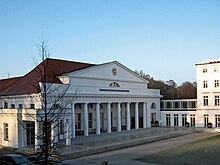Kurhaus Heiligendamm
The Kurhaus Heiligendamm is a classical building in the Heiligendamm district of Bad Doberan in the Rostock district in Mecklenburg-Western Pomerania , which is used as the restaurant of the Grand Hotel Heiligendamm.
history
The Kurhaus is a stretched, plastered hall building with a hipped roof on the property at Prof.-Vogel-Straße 5b , which was built by Carl Theodor Severin in the years 1814–1816 according to an order from Friedrich Franz I. It is one of the most important buildings of North German Classicism under the influence of the Schinkel School and can be described as the founding structure of the spa architecture . As early as 1856, the building was expanded on the west side with a new hall and a series of four lounges, and a small pillar building with a flat ceiling was added on the east side.
architecture
The harmoniously proportioned building is characterized by the spacious pillar porch facing the Baltic Sea in Tuscan order with a triangular gable arranged above it, which is flanked on each side by an axis with a large three-part window and a semicircular window above. The entablature consists of an architrave , a metope and triglyph frieze , over which there is an attic with the motto in the middle : HEIC TE LAETITIA INVITAT POST BALNEA SANUM (“Here you can expect joy, you get out of the bath well”). Above it is a second parapet with a lunette window in the middle, at the top is the triangular gable field with a renewed clock in the middle, the original work of which can be viewed in the tower clock museum in Seehausen . The proportions as well as details such as the bezel window are traced back to Andrea Palladio and English Palladianism .
Over the windows in the vestibule there are white reliefs with tritons and nereids on a blue background in the style of Wedgwood ceramics , in the center above the entrance Hygieia , the goddess of healing. At the rear, residential and farm buildings were formerly grouped around an inner courtyard with arcades, which were replaced by new buildings during a renovation in 1856, whereby the main building was also changed. In an upper floor room, four wall panneaux of a printed French wallpaper with depictions of Swiss mountain panoramas from around 1840 can be seen, which come from the Villa Medini in Bad Doberan. The rest of the interior furnishings of the rooms have not been preserved.
Surroundings
In the immediate vicinity is the memorial stone for the fifty-year anniversary of the seaside resort in 1843, a monumental granite boulder with the inscription "Friedrich Franz founded Germany's first seaside resort here 1793–1843", which was transported here from the location 10 km away at Elmenhorst , a remarkable one for this period technical performance.
literature
- Gerd Baier, Horst Ende, Brigitte Oltmanns: The architectural and art monuments in the Mecklenburg coastal region . Henschel Verlag, Berlin 1990, ISBN 3-362-00523-3 , p. 266 .
- Georg Dehio : Handbook of the German art monuments. Mecklenburg-Western Pomerania. 2nd Edition. Deutscher Kunstverlag, Berlin / Munich 2016, ISBN 978-3-422-03128-9 , SS 44.
Web links
Individual evidence
- ↑ a b c Judith Gros Chang: Bäderarchitektur in Doberan-Heiligendamm. The buildings of Carl Theodor Severin. opaion Nägelke & Neumann, Kiel 1999, ISBN 3-9806808-1-9 , pp. 77-84.
Coordinates: 54 ° 8 ′ 37.4 ″ N , 11 ° 50 ′ 31.5 ″ E


